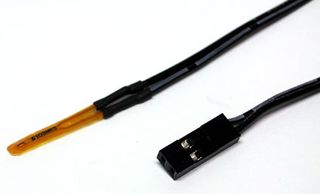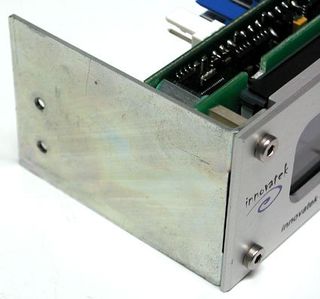Paying The Price For High-End Fan Control
Sensors, LEDs And Fans, Continued
LEDs and temperature sensors are connected to the Fan-O-Matic using a connector strip, whereby each sensor is hooked up via a two-pin connector. That means that only the sensors you need at any given time have to be connected. The ports for the LEDs can be set to either of two operating modes. In normal mode a standard TTL (5V logic) signal is output to the ports and thus can be used to control other components. In LED mode the voltage is reduced and the current strength is limited to 20 mA. This enables LEDs to be operated directly on the fan controller without an annoying dropping resistor.

One of the Fan-O-Matic's temperature sensors. Thanks to the unit's flat design, the sensors are easy to mount inside.

View of the connector strips: S1-S8 are reserved for the sensors, L1-L8 are for connecting LEDs.

Sensor 1 has just been connected.
Besides the USB port, you'll notice two blue three-pin jacks. These belong to the so-called "inno bus" (also called i-bus), which is a special bus system developed by Innovatek. This is where extra expansion components like the Fan-O-Matic Micro are connected to the base unit.
Yet another port is to be found on the board: again, a three-pin Molex connector with the label MB-SIG. The motherboard can receive a status signal from the Fan-O-Matic via a connection cable, meaning the fan controller can also be monitored via the motherboard software, for example.

Next to the USB port are two ports for the inno bus. The motherboard can monitor the Fan-O-Matic via the "MB-SIG" signal.
Stay on the Cutting Edge
Join the experts who read Tom's Hardware for the inside track on enthusiast PC tech news — and have for over 25 years. We'll send breaking news and in-depth reviews of CPUs, GPUs, AI, maker hardware and more straight to your inbox.
Two glaring minus points are apparent here: If the fan controller is already installed inside a tower, the connectors are nearly impossible to get at. Either you have to fool around with a pair of tweezers for hours on end trying to plug in the sensors and LEDs, or you can unscrew the fan controller and remove it from the case and tinker with it to your heart's content.
The second irritation is that the device can't be used in every case: If you have housing with drive rails, you can run into problems. The manufacturer should really ponder another framework for the controller.

Not for use in every case: The fan controller can't be mounted with drive rails.
Current page: Sensors, LEDs And Fans, Continued
Prev Page A Fan Controller For $240? Next Page Faster With USB?Most Popular

